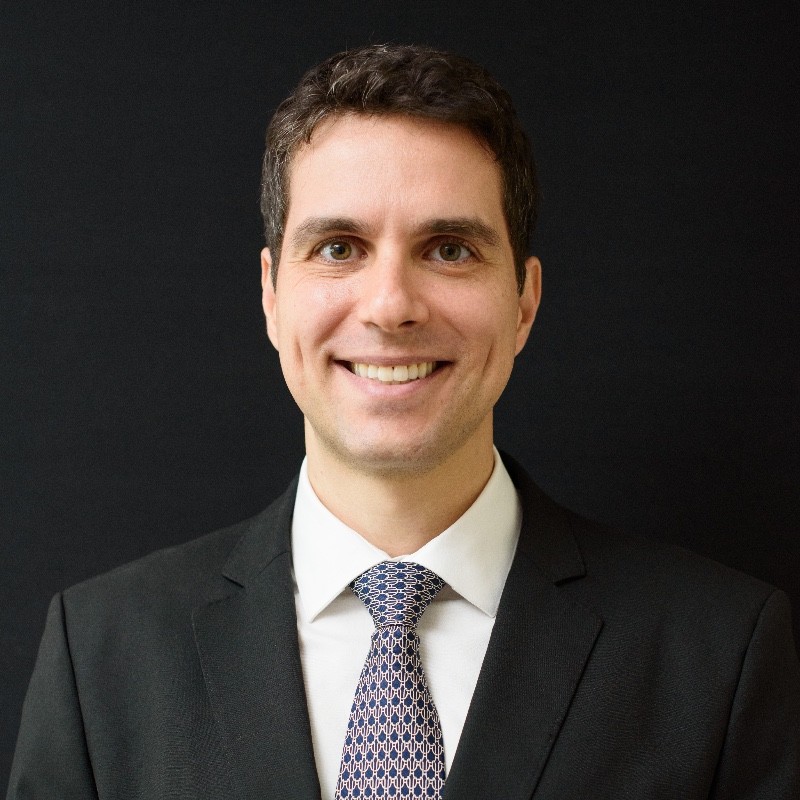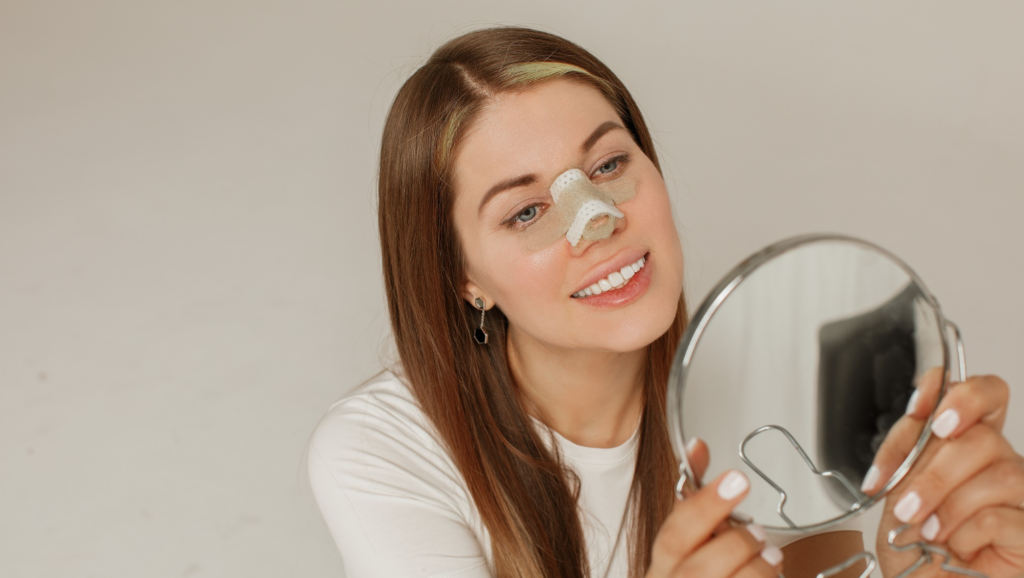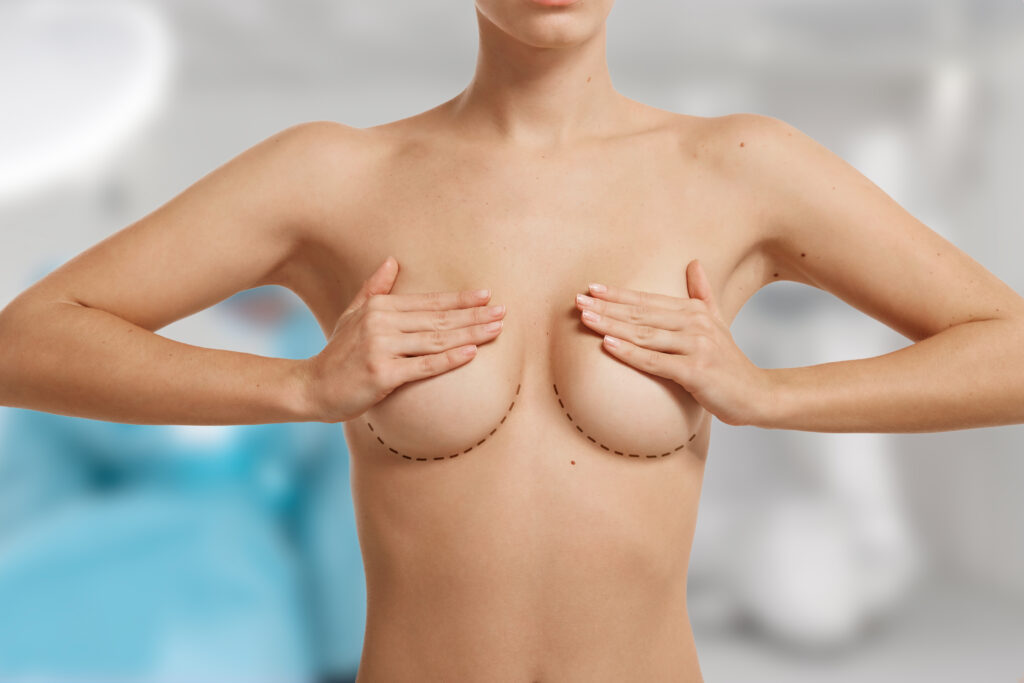Are you tired of feeling self-conscious about your nose? Do you find yourself battling breathing difficulties, or perhaps you’re simply curious about how a rhinoplasty procedure could enhance your life? So, you’re in the right place.
Together with plastic surgeon Rafael G. S. Costa, we will discuss all about rhinoplasty, including the different types, the procedure itself, the recovery period, and the cost. We will also show the before and after, so you can observe the results of rhinoplasty month by month evolution and get an idea of what the procedure can bring about.
So, if you’re ready to discover how rhinoplasty can make a positive change in your life, keep reading!
Read our article to learn more about the differences between nose shaping types and make an informed choice for your needs.
Why Get Rhinoplasty?
Rhinoplasty, often referred to as a “nose job”, serves as a transformative procedure that transcends both aesthetics and function.
One of the reasons that people decide to do rhinoplasty is that the nose can become a source of discomfort if they are dissatisfied with its size or shape. Unlike some imperfections that can be concealed or disguised, the nose stands as a challenging aspect of the body to address.
However, the reasons for seeking rhinoplasty extend beyond purely aesthetic concerns.
Many individuals also face functional issues related to their noses, which can severely affect their quality of life. Breathing difficulties are not uncommon, and this procedure can offer an opportunity to rectify these issues, improving airflow and overall comfort.
Remarkably, these functional and aesthetic concerns need not be mutually exclusive; some patients opt to address both aspects simultaneously, as the recovery process for both procedures can be quite similar. Thus, rhinoplasty stands as a versatile solution, catering to the unique needs and desires of each individual patient, whether they seek to enhance their appearance or breathe easier.

Age Requirements
However, the majority of rhinoplasty procedures are sought by younger individuals, primarily those in their late teens and early twenties. This trend can be attributed to the heightened importance of facial aesthetics during this phase of life.
Nevertheless, exceptions can be made for patients under 18, particularly if they exhibit a high degree of self-awareness and are deeply bothered by their nasal appearance.
When there is a conscious and well-informed teenager over the age of 16 who, alongside their family or legal guardians, is dedicated to the decision, rhinoplasty becomes a feasible option.
📌 However, the ability to proceed with surgery is always made with careful consideration and in consultation with medical professionals to ensure the best outcome for the patient’s physical and emotional well-being.
Types of Rhinoplasty Surgeries
Rhinoplasty surgeries encompass a range of specialized procedures tailored to address distinct concerns related to both the external and internal aspects of the nose, with a focus on enhancing aesthetics and functionality. So, how is a rhinoplasty performed and what types are included?
- Open rhinoplasty
Open rhinoplasty is a surgical approach involving a carefully placed incision on the columella, the strip of skin that separates the nostrils. This meticulous technique grants the surgeon unparalleled visibility and access to the internal structures of the nose. It is particularly suited for intricate or extensive nasal reconstructions, allowing for precise adjustments to the cartilage and bone [1, 2].
📌 Open rhinoplasty is often chosen when a substantial transformation of the nasal structure is necessary.
- Closed rhinoplasty
In contrast, closed rhinoplasty requires incisions to be made solely within the internal confines of the nose, without any external cuts. This method is typically favored for less complex cases, where minor refinements to the nasal structure are the primary objective [3].
Closed rhinoplasty offers the benefit of leaving no visible external scarring and often results in a shorter recovery period.
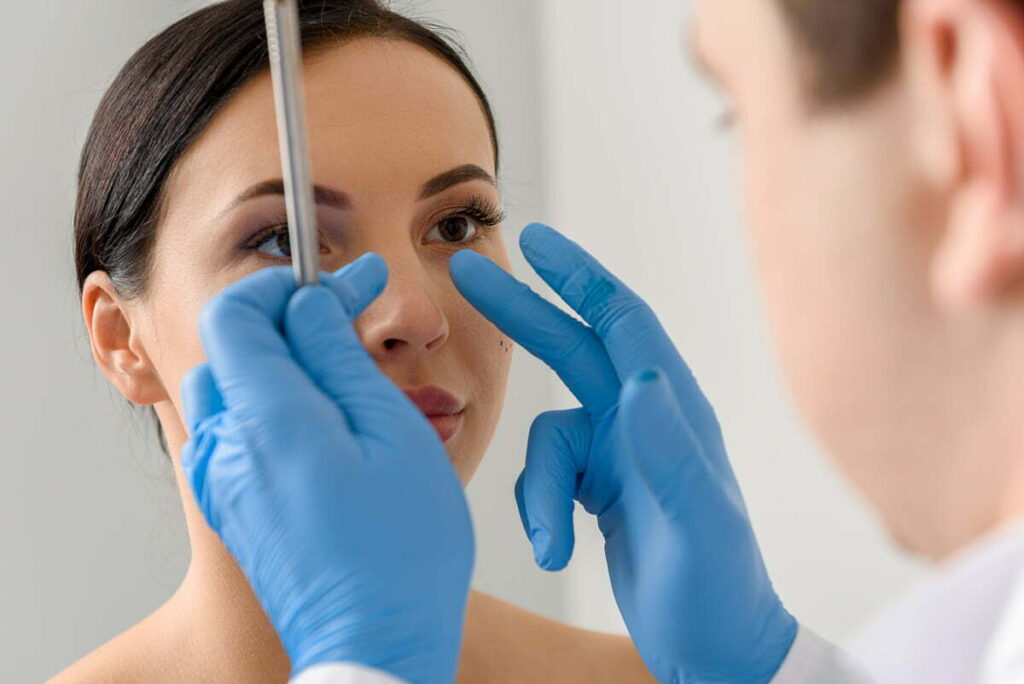
- Tip plasty (nose tip rhinoplasty)
Tip plasty stands as a specialized rhinoplasty variation exclusively dedicated to the refinement and reshaping of the nasal tip.
This procedure is sought after by individuals content with the overall appearance of their nose but seeking specific enhancements in the tip area. Such refinements may include reducing bulbosity, narrowing, or modifying the tip’s projection [4].
- Septorhinoplasty
Septorhinoplasty represents a comprehensive approach that combines cosmetic enhancements with functional improvements to the nasal septum.
In addition to achieving aesthetic goals by enhancing the overall appearance of the nose, this procedure addresses functional concerns, such as correcting a deviated septum that may impede breathing.
Septorhinoplasty effectively alleviates breathing difficulties while concurrently delivering aesthetic enhancements [5].
Rhinoplasty Procedure Steps
If you’re considering rhinoplasty, it’s essential to understand the various steps involved in this surgery.
Below, we will walk you through the stages of the rhinoplasty procedure, from the initial consultation to the postoperative care that ensures a smooth and successful recovery.

Preparing for Procedure
Preparing for a rhinoplasty procedure involves several essential steps, encompassing both medical evaluations and thorough discussions with the patient to set realistic expectations:
- Preoperative examinations
Medical assessments are fundamental in the preparation process.
This includes blood tests and, notably, a CT scanCT scan, or computed tomography scan, is a medical imaging technique used to create detailed images of the body's internal structures. to provide a comprehensive view of the internal nasal structure.
These examinations serve two primary purposes: to ensure the patient’s overall health is suitable for surgery and to help the surgeon understand the patient’s unique nasal anatomy, facilitating precise planning.
- Patient consultation and expectation setting
Equally important as the technical aspects of the procedure is the emotional and psychological preparation of the patient.
Surgeons often engage in open dialogues with patients to understand their expectations, concerns, and aesthetic desires.
“During an in-depth consultation, we take the time to understand our patients’ expectations and aspirations. It’s about building a picture between what’s technically feasible and what truly satisfies the patient. Achieving a successful outcome hinges on this balance.”
— Plastic surgeon Rafael G. S. Costa
- Preoperative preparations
Patients are typically provided with preoperative instructions, which may include guidelines on medications to avoid before surgery, fasting requirements, and postoperative care preparations.
Additionally, your surgeon may advise you to abstain from specific supplements, including vitamin E supplements, fish oil, ginseng, and others, as part of your preoperative preparation.
Following these instructions is crucial to ensure a safe and smooth surgical experience.
How Rhinoplasty is Performed?

Step 1: Anesthesia
The type of anesthesia used in a rhinoplasty procedure is determined during the preoperative assessment and consultation. The options include:
- Local anesthesia with sedation
In this approach, the patient is awake but relaxed and pain-free. The surgeon administers local anesthesia to numb the nose, and the patient is given sedatives to induce a state of relaxation and drowsiness.
- General anesthesia
With general anesthesia, the patient is completely asleep and unaware during the procedure. This is typically used for more complex rhinoplasty surgeries.
Step 2: Incisions
The choice of incision technique is determined by the surgeon based on the patient’s specific goals and the complexity of the procedure.
Step 3: Reshaping the nose
Once the incisions are made and the surgical area is accessible, the surgeon begins the process of reshaping the nose to align with the patient’s goals and the preoperative plan. The specific techniques employed during this step can vary significantly depending on the individual patient’s needs.
Typical procedures include:
- Reducing or removing excess bone or cartilage to address bumps or humps on the nasal bridge.
- Refining the nasal tip by reshaping and sculpting the underlying cartilage.
- Adjusting the size and shape of the nostrils.
- Correcting a deviated septum to improve breathing and overall nasal function.
“In my practice, I often employ the technique of lifting the nasal skin to access the underlying cartilage and bones. This allows for precise adjustments and ensures that we can achieve a more harmonious appearance that aligns with our patient’s desires.”
— Plastic surgeon Rafael G. S. Costa

Step 4: Sutures and splints
Following the reshaping of the nose, the surgeon carefully closes the incisions using sutures.
- In closed rhinoplasty, dissolvable sutures are typically placed inside the nose, hidden from view.
- In open rhinoplasty, both internal and external sutures may be used to ensure proper closure.
📌 Additionally, a splint or cast is often applied externally to the nose. This provides support to the newly shaped nasal structures and safeguards them during the initial healing phase.
Step 5: Recovery room
After the surgical procedure is completed, the patient is gently moved to the recovery room. Here, they are closely monitored as they gradually awaken from the effects of anesthesia.
The time spent in this room is relatively short, and patients continue their recovery process under medical supervision.
However, this timeframe can be influenced by various factors, including the complexity of the surgery and whether it is a primary or not (revision rhinoplasty). In the second case, the operation time can last up to four or even five hours.
🧐 Curious about what to expect from the procedure? Check out our article to explore before and after rhinoplasty results and see how effectively this surgery can meet your expectations.
Postoperative Period

The post surgery rhinoplasty period following rhinoplasty is a crucial phase in the journey toward achieving the desired results.
In the initial days following surgery, patients may encounter challenges in breathing due to nasal swelling, and visible bruises may persist for approximately 10 to 15 days.
As for rhinoplasty recovery time, there are distinct stages to consider.
- The first week post-surgery tends to be the most challenging, marked by heightened edema and breathing discomfort.
- Around the two-week mark, most bandages are removed, and while some swelling and bruising may persist, breathing improves.
- Within a month, patients can often return to their regular activities, especially if they involve minimal physical exertion. For those engaging in strenuous performance or athletics, little by little return may be necessary. In the meantime, you will gradually observe the results.
📌 Regular postoperative visits with your surgeon are crucial during this phase, as they enable to closely monitor progress and address any concerns that may arise.
Before and After Results
People considering a nose job often want to know what changes to expect. Rhinoplasty recovery photos can help them visualize the results of surgery. So, let’s look at some of them.

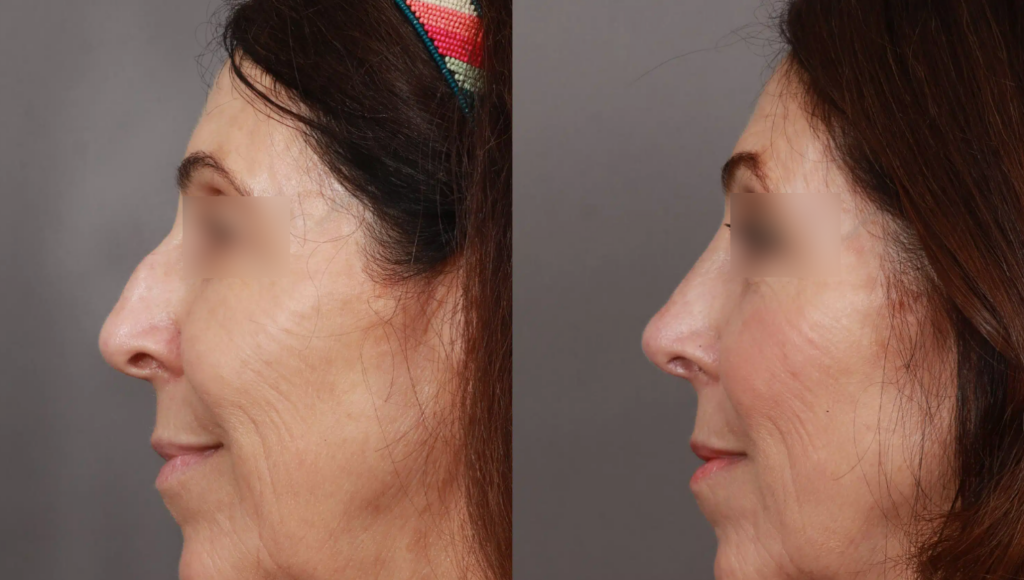
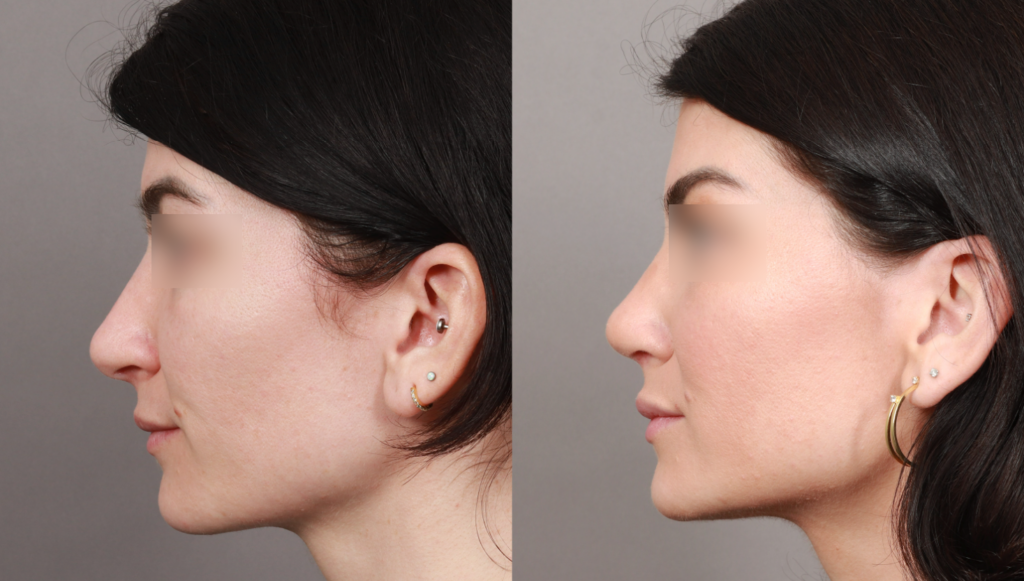

These photos showed the rhinoplasty progression month by month. However, it is important to remember that everyone’s body heals differently, so the timeline and results for rhinoplasty recovery can vary.
How Long Does it Take to See the Final Result?
The final results of rhinoplasty, where you can fully appreciate the outcome of the procedure typically become evident after approximately one year. During this time, the nose undergoes a gradual transformation and the swelling gradually subsides.
“Within the first month, patients typically notice a reduction in swelling, and by three months, a substantial improvement is usually visible, with around 70% of the edema resolved.
However, to appreciate the full extent of the results and the nose’s final appearance, patients should be patient. The remaining 30% of swelling may take up to a year to completely dissipate.”
— Plastic surgeon Rafael G. S. Costa
Based on this, while a very reasonable and pleasing result can be observed within three months, it’s important to consider the final outcome after the first year, as this is when the nose has typically settled into its permanent shape.
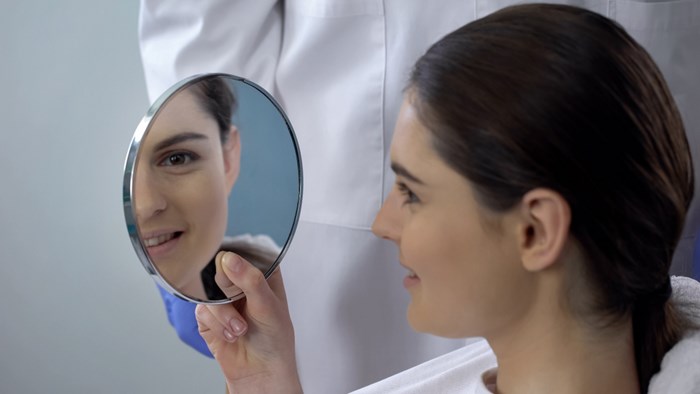
Dos and Don’ts During Recovery
Ensuring a smooth and successful recovery after rhinoplasty involves paying close attention to both what to do and what to avoid during the healing process.
Dos:
✅ Follow postoperative care instructions
First of all, adhere to the specific postoperative care instructions provided by your surgeon, including any prescribed medications, nasal care routines, and follow-up appointments.
✅ Keep the nose area dry
During the initial 15 days, it’s advisable to avoid wetting the rhinoplasty dressing. You can take a shower or bath, but be cautious not to get the nose area wet.
✅ Elevate your head
Sleep with your head elevated, using extra pillows to reduce swelling and improve comfort during the initial recovery period.
✅ Wear lightweight glasses
If you require eyeglasses, opt for lightweight frames or consider using contact lenses, especially during the first 15 days. Heavy glasses can exert pressure on the healing nasal structures.
✅ Practice patience with physical activities
Refrain from engaging in strenuous physical activities or contact sports for at least the initial three months following surgery. This precaution helps prevent accidental impacts to the nose, ensuring a safer recovery period.

Don’ts:
❌ Picking or touching your nose
Resist the urge to touch or pick at your nose, as this can disrupt the healing process and potentially lead to complications.
❌ Blow your nose
After rhinoplasty, you will experience nasal congestion (caused by inflamed tissue) for several weeks. You must resist blowing your nose to ensure that they do not interfere with healing.
❌ Long sun exposure
Excessive sun exposure can lead to increased swelling and scarring. During your recovery period, it’s advisable to protect your nose from direct sunlight by wearing a wide-brimmed hat.
❌ Use straws
Sipping through a straw can create suction and pressure in the nasal area, potentially causing complications. Opt for drinking from a glass or cup.
❌ Smoking after surgery
Equally important is the commitment to avoid smoking for as long as possible after rhinoplasty surgery. It can impede proper tissue healing and potentially lead to unfavorable scarring, asymmetry, or changes in skin quality that may affect the appearance of the nose.
By taking rhinoplasty care, you can help ensure a smoother and safer recovery process, ultimately contributing to the success of your procedure.
Common Risks Associated With Rhinoplasty
Undergoing rhinoplasty, like any surgical procedure, involves certain risks and potential complications.
🔍 General complications
Any surgical procedure, no matter how routine, carries a risk of general complications, including adverse reactions to anesthesia. It’s important for patients to undergo a thorough pre-operative evaluation to assess their overall health and suitability for surgery.
While serious general complications are rare, they cannot be entirely ruled out, making pre-operative health assessment critical.

🔍 Local complications
Local complications specific to rhinoplasty include:
- Bruising and hematomas
These are common in the postoperative period but are usually temporary and resolve with time.
- Infections
Although rare, infections can occur following surgery. Proper post-operative care and antibiotics can help mitigate this risk.
- Necrosis
In some cases, the skin of the nose may experience necrosis, which can lead to small wounds. This complication is infrequent but needs prompt medical attention.
🔍 Long-term complications
It is also worth considering the long-term effects that may occur after this operation.
- Changes due to aging
Over time, the nose, like the rest of the body, undergoes changes due to aging. Cartilage and bones can shift slightly, and small changes in the nose’s appearance may occur. These changes are usually subtle and do not necessarily warrant further surgery.
- Scars
In open rhinoplasty, a small scar may be visible on the columella (the tissue between the nostrils). However, it is typically discreet and well-hidden.
Rhinoplasty Cost
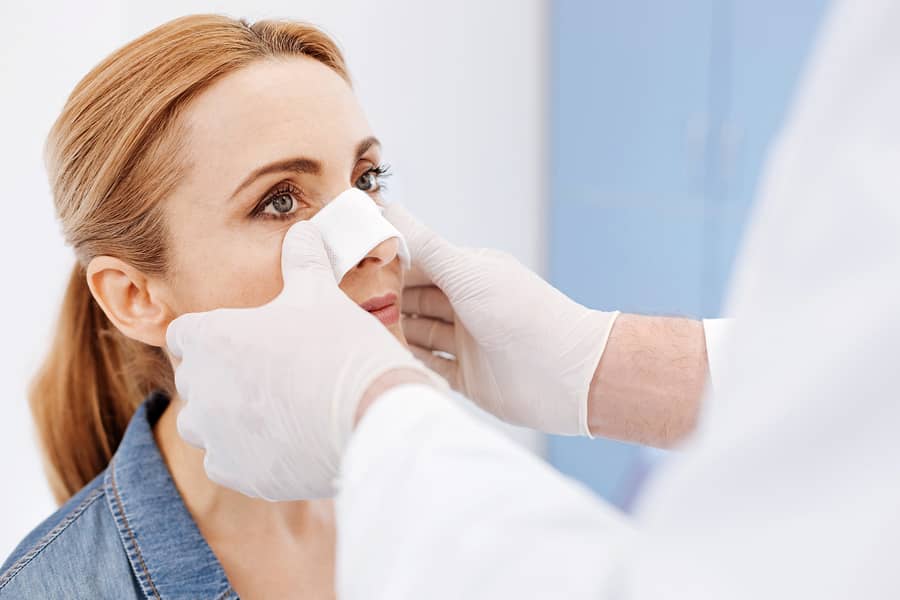
The cost of rhinoplasty varies based on several factors, with the surgeon’s experience and the quality of the surgical team and facility being significant determinants.
📌 It’s crucial not to compromise on the quality of care and infrastructure during the procedure, as safety should always take precedence. Patients should understand that the expense encompasses various elements, including the surgical team, hospital facilities, and the complexity of the procedure, making it inadvisable to cut corners when it comes to a surgery that can significantly impact one’s life.
Furthermore, the complexity of the rhinoplasty procedure itself can impact the cost. Some patients require more extensive work to achieve their desired results, which may involve more time in the operating room and potentially higher fees.
Choosing a Plastic Surgeon
When choosing a surgeon for your rhinoplasty, there are several critical factors to consider.
- Firstly, it’s essential to ensure that the surgeon is board-certified in plastic surgery or a related field, such as craniofacial surgery or otorhinolaryngology, depending on your specific needs.
- Seeking recommendations from friends, family members, or acquaintances who have had successful rhinoplasty procedures can be valuable.
- Once you’ve identified potential surgeons, schedule consultations with them.
During these visits, pay close attention to how the surgeon communicates with you. Assess their ability to clarify the procedure, address your concerns, and establish a rapport. Feeling comfortable and confident in your chosen surgeon’s abilities and approach is crucial.
Alternatives to Rhinoplasty
This approach allows for nasal enhancements and corrections without the need for surgery, offering convenience and flexibility.
Dr. Rafael emphasizes that while it’s a simpler procedure than traditional rhinoplasty, it is a medical, not aesthetic, procedure. This non-surgical approach allows for subtle changes to the nose’s shape, addressing specific concerns or enhancing certain features.
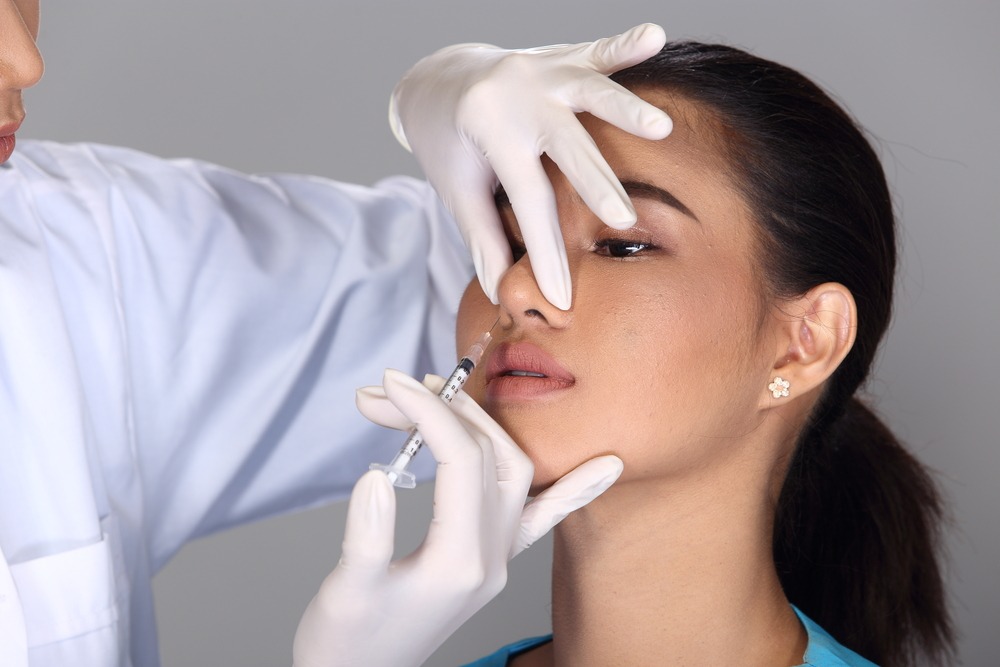
📌 However, it’s important to note that the results are temporary, and individuals may need repeat treatments to maintain the desired look.
These strips adhere to the outside of the nostrils, helping to expand the nasal passages and reduce airflow resistance. While they don’t address aesthetic concerns, they can be a valuable option for individuals primarily seeking improved nasal airflow and less congestion.
The Verdict
Rhinoplasty offers many options for people looking to improve their appearance or nasal function. Together with Rafael G. S. Costa, a plastic surgeon, we’ve looked at the different types of rhinoplasty, how the surgery works, and what to expect afterward. If you’re unsure about the operation, we’ve also explored non-surgical alternatives.
Rhinoplasty is more than just changing your nose’s shape; it’s about boosting confidence, improving function, and enhancing your quality of life. We hope this article has given you the information you need to make informed decisions about the rhinoplasty procedure.
Remember, picking the right surgeon and understanding the process well are crucial for a successful outcome.
FAQ
👃 Rhinoplasty – what does it mean?
Rhinoplasty, often called a “nose job,” is a surgical procedure that can reshape and enhance the appearance of your nose. It’s done for cosmetic reasons or to improve breathing problems.
🧐 How long after rhinoplasty can I blow my nose?
It’s best to avoid blowing your nose forcefully for at least the first week after rhinoplasty. During this time, your nose is delicate and needs to heal without disruptions. Instead, use gentle saline nasal sprays to keep your nasal passages clear.
🛌 How to sleep after rhinoplasty?
After surgery, it’s best to sleep with your head propped up at a slight angle. This helps reduce swelling and improves blood circulation. You can achieve this by using extra pillows or a wedge-shaped pillow. Sleeping on your back is the preferred position to avoid putting pressure on your nose and ensure a smooth recovery.
🔍 How long does rhinoplasty recovery take?
Rhinoplasty recovery time varies, but most patients see significant improvement in swelling and bruising within the first two weeks. It can take several months for the final results to show as swelling gradually goes down. In general, it’s considered a full recovery after about one year.
References
- Adamson PA. Open rhinoplasty. Otolaryngol Clin North Am. 1987 Nov;20(4):837-52. PMID: 3320871.
- Ozturk A, Eroglu S, Batmaz T, İlhan AE, Gode S. Functional Role of Scroll Reconstruction in Open Rhinoplasty. Aesthetic Plast Surg. 2021 Aug;45(4):1732-1737. doi: 10.1007/s00266-020-02125-y. Epub 2021 Jan 28. PMID: 33507350.
- Azzawi SA, Kidd T, Shoaib T. Closed Rhinoplasty: A Single Surgeon Experience of 238 Cases over 2 Years. Indian J Otolaryngol Head Neck Surg. 2022 Sep;74(3):255-259. doi: 10.1007/s12070-020-01990-y. Epub 2020 Aug 6. PMID: 36213464; PMCID: PMC9535069.
- Lee KC, Kwon YS, Park JM, Kim SK, Park SH, Kim JH. Nasal tip plasty using various techniques in rhinoplasty. Aesthetic Plast Surg. 2004 Nov-Dec;28(6):445-55. doi: 10.1007/s00266-004-0020-x. Epub 2004 Dec 2. PMID: 15580432.
- Simsek T, Erdoğan MM, Özçetinkaya Erdoğan S, Kazaz H, Tezcan E, Seyhan S. Assessment of functional and aesthetic outcomes in septorhinoplasty. Eur Arch Otorhinolaryngol. 2021 Apr;278(4):1089-1097. doi: 10.1007/s00405-020-06387-9. Epub 2020 Sep 29. PMID: 32995911.
